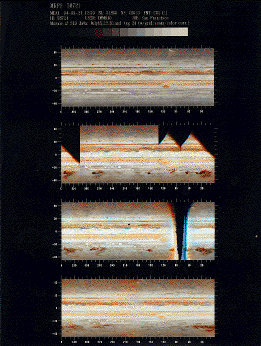

NOTE: Click on the image to view it at its highest resolution.
PHOTO RELEASE NO: STScl-PRC94-47
This series of color-composite maps of Jupiter, assembled from images taken with NASA's Hubble Space Telescope, allows astronomers to trace changes in the dark impact sites that resulted from the July 1994 impact of comet P/Shoemaker-Levy 9 with the giant planet. Through computer image processing, researchers "peel" the atmosphere of Jupiter off its globe and spread it flat onto a map. These cylindrical projections show the entire atmosphere of Jupiter in one map. The HST images show clearly that dark material produced in the comet explosion has continued to spread in Jupiter's atmosphere. However, the "band" of dark material is still clumpy, which suggests that the major impact sites are still localized and, so, can still be identified.
Top: A pre-impact mosaic of Jupiter taken 15 July 1994 shows complex atmospheric features, zones, belts, and cells that are normal for Jupiter's dynamic weather system.
Second from Top: This map is assembled from images taken on 23 July 1994, immediately after the impacts ended. Though most of the impact sites are fresh, Jupiter's winds are already changing their shape. At this point, most of the material spreads east-west, along latitude lines. However, some north-south spreading appears in HST high-resolution images.
Second from Bottom: In this mosaic made from HST images obtained on 30 July 1994, dramatic changes are evident a week after the bombardment. As dark material drifts southward from the impact sites, it is caught up in eastward and westward jets. The shearing is consistent with the wind direction and speed, as measured by tracking small, normal Jovian atmospheric disturbances.
Bottom: The dark material continues to spread and thin, in this map assembled from observations taken on August 24, though there are still localized sites of disturbance. The color of the features has not changed significantly in the weeks after the impacts. This suggests that there were no major longterm chemical modifications of the material once it stabilized after impact (although dramatic chemical changes were reported on short timescales immediately after the impacts). Subtle longterm changes in chemistry are still possible, though.
H. Hammel, MIT and NASA
![]() Images, Images, Images
Images, Images, Images
